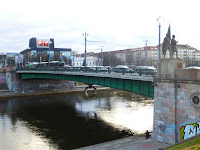 Vilnius
Vilnius was granted city status in 1387 and today is the capital of
Lithuania. It's in the southeast part of the country and has a population of almost 543,000 while over 807,000 live in the greater metro area. Vilnius is the country's largest city and, after
Riga, it is the second largest in the
Baltics.

Prior to WWII there were more than 100 synagogues in Vilnius. In 1812, Napoleon called the city "the Jerusalem of the North." However, there's a church everywhere you turn in this city. There are 65 churches in Vilnius. The historic old town was listed as a
UNESCO World Heritage Site in 1994.

The Gate of Dawn was built between 1503 and 1522. This is the last remaining city gate which was part of the city's defense system. The other eight city gates were destroyed by the government back in the 18th century.
 |
| Vilnius Town Hall |

The Choral Synagogue was built in 1903. It is the last remaining synagogue in the city.

The Russian Orthodox Church of St. Nicholas is one of the oldest Orthodox churches in the city. The original church was built in 1340. The current church was reconsecrated in 1866.

The Russian Orthodox Church of St. Parasceve was built in 1865.

The Cathedral of St. Stanislaus and St. Ladislaus is a Roman Catholic
basilica. The current church dates back to around 1419. The bell tower
is not so common outside of
Italy.

The most famous church is probably St. Anne's. The church was consecrated in 1500 and is made from 33 different styles of brick.

The Gediminas Castle Complex dates back to the 13th century. During
Russian occupation in the mid-1600's its defensive walls and towers were
destroyed. There is one remaining tower and the complex is part of the
national museum.

The Green Bridge crosses the Neris River. The original bridge dated back to the 16th century and it was the oldest in the city. The present bridge was completed in 1952 and displays Soviet-era socialist statues.

Seimas Palace is the Lithuanian parliament building. It was completed in 1980.

The Hill of the Three Crosses is a prominent landmark in Kalnai Park. Legend has it that seven Franciscan friars were beheaded on top of the hill. In the 17th century wooden crosses were put here until concrete ones were erected in 1916. The Soviet government tore it down in 1950 but it was replaced in 1989. A hike up the hill gives a nice view of the city.
 Update:
Update: In July 2015, the government removed the statues from the Green Bridge. The statues were erected in 1952 and are corroded. They have been removed for repairs but there are no plans for them to be returned.
 Vilnius was granted city status in 1387 and today is the capital of Lithuania. It's in the southeast part of the country and has a population of almost 543,000 while over 807,000 live in the greater metro area. Vilnius is the country's largest city and, after Riga, it is the second largest in the Baltics.
Vilnius was granted city status in 1387 and today is the capital of Lithuania. It's in the southeast part of the country and has a population of almost 543,000 while over 807,000 live in the greater metro area. Vilnius is the country's largest city and, after Riga, it is the second largest in the Baltics.

























No comments:
Post a Comment